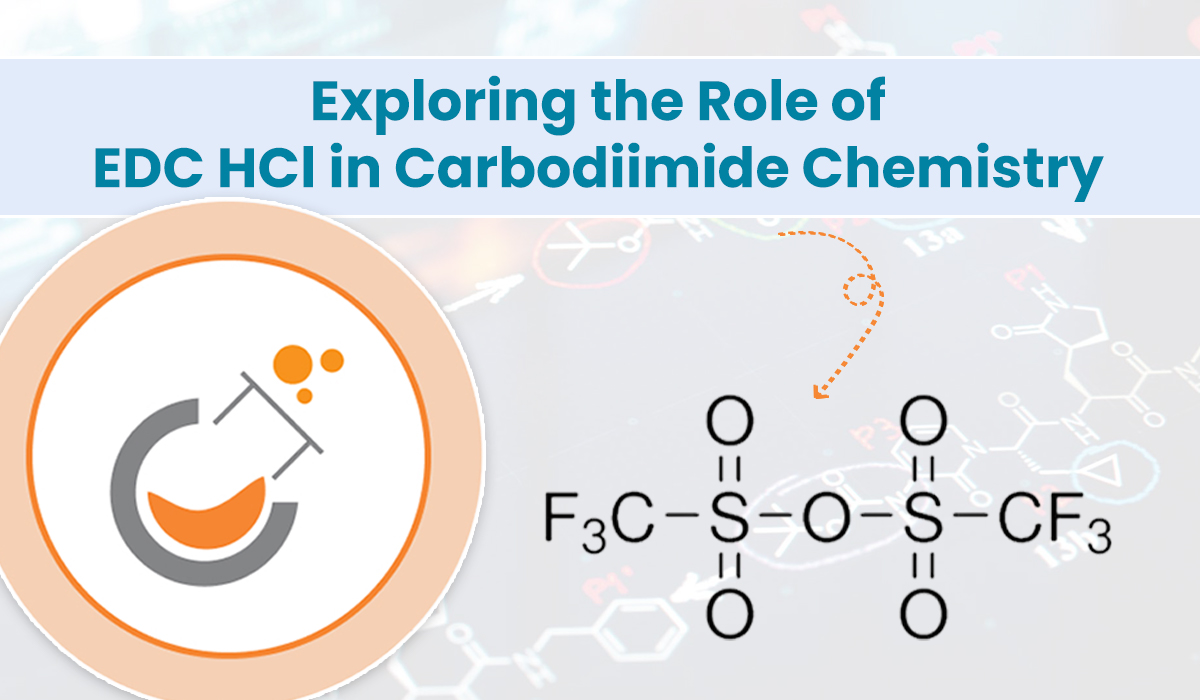This several carbodiimide chemistry has been the linchpin in contemporary synthetic organic and bioconjugation procedures. Among such reagents, EDC HCL finds its place as one of the most useful, and its preferential use is because of its unique capability of catalyzing amide bond formation under extremely mild conditions-it is therefore most important in peptide synthesis, biomolecule modification, and carboxyl to amine coupling reactions.
In this article, we’ll explore the role of EDC HCl in carbodiimide chemistry, how it works at the molecular level, its advantages, limitations, and common applications in laboratory and industrial contexts.
What Is Carbodiimide Chemistry?
The carbodiimides constitute a group of reagents most noted for their use in coupling reactions. They have in their structure the functional group –N=C=N– and act as dehydrating agents. Effectively, this makes carbodiimides highly efficient in aiding amide bond formation-one of the most commonly occurring linkages in organic and biochemical molecules.
Amide bonds link peptides and proteins together and are also highly consequential in pharmaceuticals, polymers, and advanced materials. The ability to efficiently, and in most instances selectively, form these bonds is of paramount importance in both research and commercial ventures.
Carbodiimides enable the coupling by activating carboxylic acids, which can then be coupled with nucleophiles such as amines.
What is EDC HCl?
It is soluble in water. The chemical formula shows:
- An ethyl group and a dimethylaminopropyl group are attached to the carbodiimide core.
- The hydrochloride salt form, which imparts stability and aqueous solubility.
Aqueous solubility is one of the characteristic properties of EDC. It being a carbodiimide, most others of this nature show poor solubility in common organic solvents, whereas EDC HCl can act satisfactorily in aqueous systems. Hence, it finds more applications in bioconjugate chemistry, where retention of biological activity often requires aqueous conditions.
Mechanism of Action
A mechanistic perspective of the reactivity of EDC HCl consists of simplified steps below:
1) Activation of the Carboxyl Group
EDC reacts with a carboxylic acid to form an O-acylisourea intermediate.
The intermediate is highly reactive but fairly unstable.
2) Coupling with an Amine (or Other Nucleophile)
The O-acylisourea intermediate interacts with a nucleophile, shallowly typically an amine, to afford the amide bond sought.
The by-product from the reaction is a urea derivative that is soluble and easily removable.
3) Use of Additives
In practice, additives such as N-hydroxysuccinimide (NHS) or sulfo-NHS are commonly added.
These create more stable intermediates, which avoid side reactions and higher yields.
Benefits of Using EDC HCl
Several characteristics account for why EDC HCl is generally preferred in carbodiimide chemistry:
Water Compatibility:
Contrasting with dicyclohexylcarbodiimide (DCC) or diisopropylcarbodiimide (DIC), EDC dissolves in water and, hence, can be employed in reactions occurring in biological systems.
Water-Soluble Byproducts:
The urea byproducts produced are water-soluble, simplifying the purification process compared to that of water-insoluble dicyclohexylurea byproducts resulting from DCC reactions.
Mild Conditions:
The reaction takes place under ambient conditions at physiological pH and hence does not affect the sensitive molecules’ integrity.
Widespread Utility:
Useful both in small-molecule organic synthesis and in conjugating large biomolecules.
Read more about: Exploring the Versatility and Safety of EDC HCL
Limitations and Challenges
Other than its numerous advantages, EDC HCl has some limitations as well:
Intermediate Instability – In the absence of a nucleophile, which appears rapidly enough, the O-acylisourea intermediate is subject to a host of side reactions, including hydrolysis.
Need for Additives – Stabilizers like NHS are usually needed so as not to diminish its efficiency and prevent side reactions.
Cost Considerations – Cost might well be in favor of EDC HCl compared to some organic carbodiimides, especially on a large scale.
Storage and Shelf Life – Compared to some carbodiimides, EDC HCl is more stable, but it is a moisture absorber and needs to be stored in dry conditions.
Applications of EDC HCl in Carbodiimide Chemistry
The selectivity of EDC HCl manifests itself in various fields:
1. Coupling of Peptides :
EDC finds common application in the coupling of amino acids to produce peptides. Together with the NHS, it gives an efficient and high-yielding bond formation without the insoluble by-products that can complicate the purification.
2. Bioconjugation :
Bioconjugation is an area in biomedical research where EDC HCl is routinely used for:
Coupling proteins to fluorescent markers or enzymes for detection.
Binding antibodies to surfaces for immunoassays.
Binding nucleic acids to carriers for gene delivery.
3. Surface Modification :
Carboxyl-functionalized surfaces, such as nanoparticles, polymers, or biosensors, can be activated by EDC for covalent linkage with amines. This builds functionalized surfaces for diagnostics, drug delivery, or tissue engineering.
4. Biological Crosslinking :
EDC crosslinks proteins through their carboxyl and amine functionalities, which is valuable for studying protein-protein interactions or for making stable biomaterials.
5. Polymer Chemistry :
In materials science, EDC is used to functionalize polymers with functional groups, paving the way to novel coatings, hydrogels, and smart materials.
Know more about :2,4-Dichloropyrimidine is an important chemical intermediate widely used in the synthesis of pharmaceuticals, agrochemicals, and specialty compounds.
EDC HCl versus Other Carbodiimides
What does EDC have that its relatives, such as DCC or DIC, do not?
DCC:
Extremely popular in organic synthesis, but creates insoluble byproducts-(dicyclohexylurea)-that need filtering. It’s less suited for aqueous systems.
DIC:
Like DCC-in solubility and instability, it has almost no use in biochemistry.
EDC HCl:
Preferring aqueous and biological chemistry, insoluble by-products, and infinitely famous for bioconjugation.
Perhaps they all have uses, but in aqueous and biological chemistry, EDC HCl is the reagent most often opted for.
Conclusion
EDC HCl carves out a small place for itself in carbodiimide chemistry due to its water solubility, mild reaction conditions, and excellent ability to form amide bonds. Despite requiring much work-up and sometimes stabilizing additives, the advantages far outweigh its disadvantages, especially when application demands precision and biocompatibility.
EDC HCl is still a reliable and useful reagent from peptide synthesis to bioconjugation, to surface functionalization, to material design. With developments in research on biomaterials, drug delivery, and diagnostics, its importance is only going to grow more.







Recent Comments